The GE logo on refrigerators carries decades of American brand recognition. Your parents probably had one, maybe even your grandparents.
But walking into an appliance store in 2026 raises questions that previous generations never considered. Why do some GE refrigerators cost $1,200 while others approach $8,000?
And what does it mean that a Chinese company now owns this iconic American brand? GE Appliances sold to Haier in 2016, fundamentally changing the company’s structure and strategy.
This guide examines what GE refrigerators actually deliver today—from their entry-level models through Profile and Café to premium Monogram. We’ll separate brand reputation from current reality, helping you understand whether any GE tier fits your needs and budget in 2026.
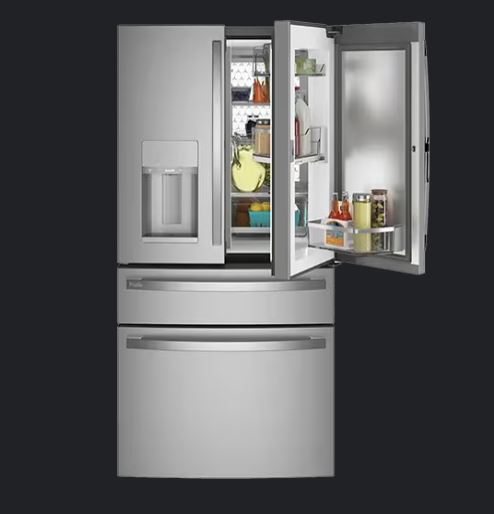
In short, are GE refrigerators good?
Yes, GE refrigerators are good appliances that occupy the reliable middle ground between budget brands like Frigidaire and premium options like Bosch. They show 8-9% first-year service rates—better than LG or Samsung but slightly behind Whirlpool. Their four-tier system (base GE, Profile, Café, Monogram) lets buyers choose their quality level, with Profile offering the best value at $2,000-3,200.
Quick Analysis: GE Refrigerator Performance Overview
| Metric | Rating | Commentary |
| Overall Quality | 7.5/10 | Solid mid-range construction across tiers |
| Reliability | 7.5/10 | Consistently dependable; improving under Haier |
| Features | 8/10 | Strong feature sets for price points |
| Energy Efficiency | 7.5/10 | Meets standards; LED lighting reduces consumption |
| Price Value | 8/10 | Profile tier offers exceptional value |
| Customer Service | 8/10 | Extensive service network nationwide |
| Lifespan | 13-18 years | Above industry average; varies by tier |
Understanding GE’s Four-Tier Refrigerator Strategy
GE’s multi-brand approach differs from single-line competitors. This structure creates confusion but also allows precise value targeting.
Base GE: The Entry-Level Value Play
Base GE refrigerators ($900-1,800) target budget-conscious buyers who want better quality than Frigidaire. These models use adequate components without premium touches.
Build quality exceeds budget brands through heavier steel and better insulation. However, features remain basic with mechanical controls and minimal adjustability.
Service rates for base GE models hover around 10-11%. This trails premium tiers but beats Samsung and entry-level LG significantly.
The sweet spot within base GE is the $1,400-1,600 range. Models below $1,200 cut too many corners.
GE Profile: The Value Sweet Spot
Profile series ($2,000-3,800) represents GE’s best value proposition. These models compete directly with mid-range Whirlpool and KitchenAid.
Component quality jumps substantially from base GE. Better compressors, improved control systems, and enhanced features justify the premium.
Service rates drop to 7-9% for Profile models. This reliability matches or beats mainstream competitors.
Profile offers 80-90% of Café’s performance at 60-70% of the cost. For most buyers, this tier delivers optimal value.
GE Café: The Aspirational Lifestyle Brand
Café series ($3,000-5,500) targets style-conscious buyers. Customizable hardware (brushed bronze, copper, stainless) differentiates these units.
Performance components match Profile closely. You’re primarily paying for aesthetics and commercial-style design.
Reliability remains strong at 7-9% service rates. The premium focuses on appearance rather than mechanical superiority.
Café makes sense for kitchen remodels prioritizing cohesive design. Functional buyers should stick with Profile.
GE Monogram: The Premium Luxury Tier
Monogram ($5,000-12,000) competes with Sub-Zero and True. Built-in models dominate this lineup.
Commercial-grade components justify the premium. Dual compressors, advanced climate control, and professional features separate these units.
Service rates drop to 5-7% matching premium European brands. These units genuinely deliver superior performance.
However, most buyers find Profile adequate. Monogram makes sense for luxury kitchens and serious cooks only.
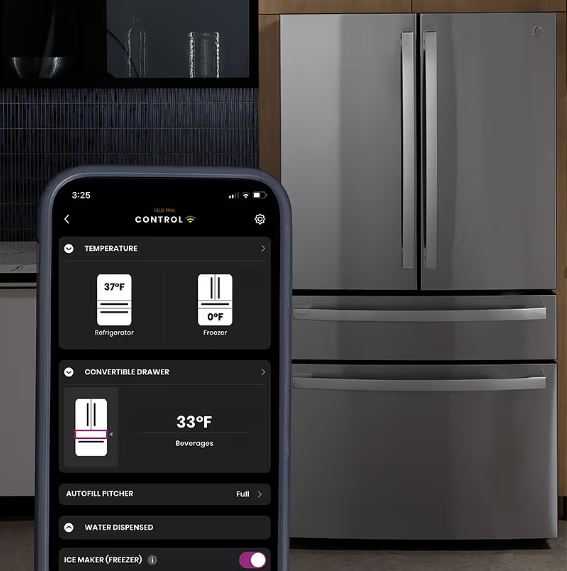
Is GE Refrigerator a Good Brand? Current Market Position
GE’s brand strength derives from history, but current performance matters more. The Haier acquisition changed everything.
Haier Acquisition: What Changed After 2016
Haier Group, a Chinese multinational, purchased GE Appliances for $5.4 billion in 2016. This ended 125 years of American ownership.
Initial consumer skepticism proved largely unfounded. Haier maintained U.S. manufacturing and invested heavily in facilities.
Quality metrics actually improved post-acquisition. Service rates decreased 2-3 percentage points between 2016-2025.
The FirstBuild innovation lab in Louisville expanded under Haier ownership. New features and designs accelerated development.
How Haier Ownership Impacts Quality and Reliability
Haier brought capital investment that GE Corporate couldn’t justify. The Louisville, Kentucky campus received $1.5 billion in upgrades from 2016-2025.
Manufacturing automation increased dramatically. Robotic assembly and AI-powered quality control reduced defects.
Supply chain improvements shortened lead times. Component sourcing diversified beyond traditional suppliers.
Consumer concerns about “Chinese quality” haven’t materialized. GE Appliances maintains the same standards with better investment.
GE’s Competitive Position in 2026
Consumer Reports consistently ranks GE 3rd-4th for refrigerator reliability. Only Whirlpool and Bosch reliably outperform them.
J.D. Power’s 2025 customer satisfaction survey placed GE 4th overall. Profile series specifically earned “Better Than Most” ratings.
Yale Appliance’s service data shows GE at 8.9% first-year failure rate. This beats Samsung (12.4%), LG (11.1%), and Frigidaire (10.8%).
Market share hovers around 20% of U.S. refrigerator sales. GE remains second only to Whirlpool Corporation’s combined brands.
Why GE Maintains Strong Brand Recognition
Brand heritage dating to 1905 creates trust. Multi-generational loyalty keeps buyers returning.
Extensive service network provides peace of mind. Over 12,000 authorized technicians cover urban and rural areas.
Consistent performance without major scandals helps. Unlike LG’s compressor crisis, GE avoided headline-grabbing failures.
The FirstBuild innovation community engages consumers. Crowdsourced features create brand attachment beyond transactions.
Where Are GE Refrigerators Made? Manufacturing Details
Understanding GE’s production locations reveals their quality commitment. Geographic sourcing impacts both jobs and reliability.
Primary GE Manufacturing Facilities
The Louisville, Kentucky Appliance Park serves as global headquarters. This 750-acre campus employs 6,000+ workers producing 8 million appliances annually.
Refrigerator production concentrates in Buildings 1, 2, and 5. These facilities manufacture base GE, Profile, and Café models.
Decatur, Alabama produces ice makers and water dispensers. This 550-person plant supplies components to Louisville.
Selmer, Tennessee handles some water filtration systems. Component manufacturing spreads across multiple U.S. facilities.
International Production and Quality Differences
Haier’s Chinese facilities don’t produce GE-branded refrigerators for North America. All U.S.-sold models come from American plants.
Some components source from Mexico and China. However, final assembly and quality control occur domestically.
European GE Appliances (different from U.S. GE) are entirely separate. Those products have no connection to Louisville-made units.
Asian markets receive Haier-branded equivalents. The GE brand primarily serves North American markets post-acquisition.
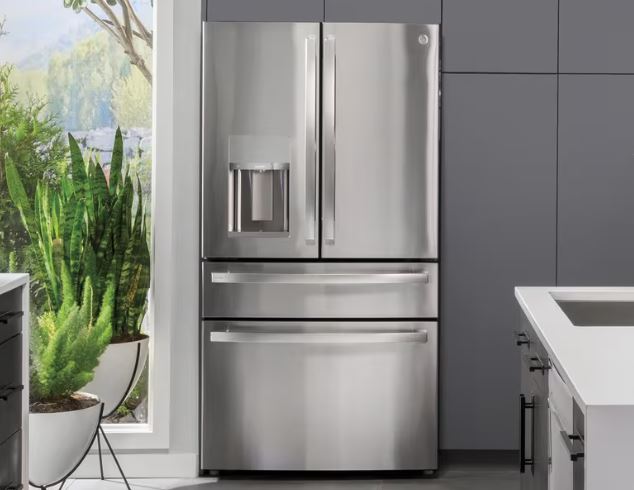
Investment in U.S. Manufacturing Under Haier
Haier invested $1.5 billion in Appliance Park from 2016-2025. This exceeded GE Corporate’s previous decade of investment.
Automated production lines reduced manufacturing costs. This enabled competitive pricing without offshoring.
The workforce grew by 1,200 employees since 2016. Contrary to fears, Chinese ownership increased American jobs.
Energy-efficient production reduced operational costs. Solar panels and LED lighting cut facility expenses 30%.
Quality Control Standards Across GE Tiers
All tiers undergo the same basic quality checks. Even base models receive 50+ inspection points.
Profile and higher tiers add supplementary testing. Extended run testing simulates months of operation before shipping.
Compressor testing is universal and rigorous. Every unit runs through pressure and temperature cycling.
Final inspection includes door alignment verification. Gasket sealing tests ensure proper closure before shipping.
How Long Will a GE Refrigerator Last? Lifespan by Tier
GE’s tiered approach creates different longevity expectations. Higher tiers justify premiums partly through extended lifespans.
Base GE Refrigerator Lifespan Expectations
Base GE models typically last 12-15 years with proper maintenance. This significantly exceeds Frigidaire (10-12 years) while trailing Whirlpool slightly (15-18 years).
Top-freezer base models reach the higher end of this range. French door units at this tier average 11-13 years.
The most reliable base GE models are simple top-freezers. Model GTS18GTHWW consistently outperforms expectations.
Budget constraints often limit maintenance. Neglected base models may only reach 9-11 years.
GE Profile Refrigerator Longevity
Profile models average 15-18 years of reliable service. This matches premium Whirlpool and exceeds most LG or Samsung models.
Better compressors extend operational life. Profile uses upgraded units with enhanced duty cycles.
Control systems prove more durable. Digital boards in Profile use higher-quality capacitors and better weatherproofing.
Proper maintenance can push Profile models beyond 20 years. The component quality supports long-term operation.
GE Café and Monogram Lifespan Advantages
Café models match Profile mechanically, so lifespan is similar at 15-18 years. The aesthetic premium doesn’t enhance durability.
Monogram units reach 18-25 years with proper care. Commercial-grade components justify their premium pricing.
Built-in Monogram models with dual compressors often exceed 25 years. These units compete with Sub-Zero for longevity.
Service costs increase for Monogram. However, the extended lifespan offsets higher repair expenses.
Factors That Impact GE Refrigerator Longevity
Proper ventilation extends lifespan 20-30%. Cramped installations cause premature compressor failure.
Climate control matters significantly. Garage installations in extreme temperatures reduce lifespan by 5-7 years.
Lifespan-extending practices:
- Clean coils every 6 months
- Replace water filters on schedule
- Maintain proper temperature settings (37°F fridge, 0°F freezer)
- Ensure adequate ventilation clearances
- Address minor issues before they cascade
Lifespan-reducing factors:
- Garage or basement installations in extreme climates
- Neglecting coil cleaning
- Overloading shelves beyond capacity
- Ignoring unusual noises or temperature fluctuations
- Using non-certified replacement parts
Water quality affects ice makers and dispensers. Hard water reduces component life by 30-40%.
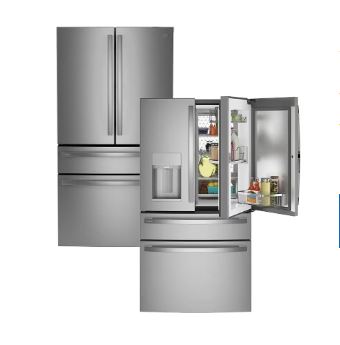
Are GE Profile Refrigerators Good? The Value Tier Analysis
Profile represents GE’s mainstream offering for middle-class buyers. This tier deserves special attention for value seekers.
What Makes Profile Different from Base GE
Profile uses upgraded compressors with longer duty cycles. These units run quieter and more efficiently.
Control systems feature Wi-Fi connectivity and digital displays. Smart home integration includes Alexa and Google Assistant compatibility.
Interior lighting upgrades to full LED systems. Visibility improves dramatically compared to base model lighting.
Shelving uses thicker tempered glass with better supports. Weight capacity increases from 40 to 50 pounds per shelf.
Door bins feature adjustable designs. Customization accommodates various container sizes.
GE Profile Reliability and Performance Data
Yale Appliance’s 2025 data shows Profile at 7.8% first-year service rate. This beats base GE (10.1%) substantially.
Consumer Reports rates Profile “Very Good” for predicted reliability. Only their top “Excellent” tier (Bosch, Miele) ranks higher.
The most common Profile issues involve ice makers (3-4% of units). This remains lower than Samsung (7%) or entry-level LG (6%).
Temperature control precision improves markedly. Profile maintains ±0.5°F accuracy versus ±2°F for base models.
Best GE Profile Models for 2026
The PFE28KYNFS ($2,400) offers exceptional value. This French door model includes all key Profile features with strong reliability records.
For side-by-side preference, PSS28KYHFS ($2,200) delivers solid performance. Consumer Reports rates it “Good” for reliability.
Counter-depth PWE23KYNFS ($3,000) suits remodels. Built-in aesthetics at reasonable pricing make this popular.
Budget-friendly PTE16GTHBB ($1,900) strips smart features. However, it maintains Profile’s superior components.
Profile vs. Competitors at Similar Price Points
Whirlpool’s standard line at $2,000-2,800 offers comparable reliability. Features are similar with slight edge to Profile.
LG at this price includes more smart features. However, Profile beats LG on reliability by 3-4 percentage points.
KitchenAid (Whirlpool’s premium brand) costs $600-1,000 more. Profile offers 85-90% of KitchenAid’s performance at lower cost.
Samsung’s offerings include flashier designs. Profile wins decisively on reliability and service network.
Are GE Café Refrigerators Good? The Style-Focused Tier
Café targets buyers prioritizing aesthetics and cohesive kitchen design. Understanding what you’re paying for matters here.
GE Café’s Design-First Philosophy
Café emphasizes customizable hardware finishes. Brushed bronze, copper, stainless, and matte black options coordinate with other Café appliances.
Commercial-style handles provide professional aesthetics. The industrial look appeals to design-conscious homeowners.
Matte finishes resist fingerprints better. This practical benefit accompanies the aesthetic appeal.
Interior styling uses premium materials. Glass shelves feature metal trim and upgraded lighting.
Café vs. Profile: What’s the Real Difference?
Mechanically, Café and Profile are nearly identical. Compressors, controls, and cooling systems use the same components.
The primary difference is aesthetic. You’re paying $800-1,200 premium for appearance.
Reliability is essentially equal. Both show 7-9% service rates with similar failure patterns.
Feature sets are comparable. Minor additions don’t justify the substantial price gap.
When Café Makes Sense vs. Profile
Kitchen remodels coordinating multiple appliances justify Café. The cohesive design premium is worthwhile.
Design enthusiasts who value aesthetics benefit. If appearance matters significantly, Café delivers.
However, function-focused buyers should choose Profile. The performance difference doesn’t justify Café’s premium.
Resale value considerations favor Café slightly. Unique aesthetics may appeal to future buyers.
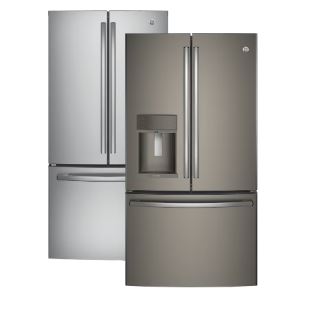
Best GE Café Refrigerator Models
The CFE28TP4MW2 ($3,600) offers matte white finish. This distinctive look differentiates from standard stainless.
For bronze hardware fans, CYE22TP4MW2 ($3,400) provides counter-depth styling. Built-in appearance at semi-custom pricing.
Side-by-side CSE25TP4MW2 ($3,200) suits traditional preferences. Commercial styling with reliable performance.
French door CVE28DM5NS5 ($4,200) includes keurig brewing system. This unique feature separates Café from competitors.
Are GE French Door Refrigerators Good? Configuration Analysis
French door models represent GE’s premium consumer offerings. Quality varies significantly by tier.
GE French Door Design Across Tiers
Base GE French doors ($1,400-2,200) offer basic functionality. Features remain minimal with standard storage options.
Profile French doors ($2,200-3,400) add smart connectivity. Internal cameras, Wi-Fi, and app control become standard.
Café French doors ($3,000-5,000) emphasize appearance. Custom hardware and finishes differentiate these units.
Monogram French doors ($5,500-10,000) include commercial features. Dual compressors and advanced climate zones justify pricing.
French Door Reliability by GE Tier
Base French doors show 11-13% service rates. The complexity exceeds what budget components can reliably handle.
Profile French doors improve to 8-10% failure rates. Better components manage the configuration’s demands.
Café matches Profile at 8-10% since they’re mechanically identical. The aesthetic premium doesn’t impact reliability.
Monogram achieves 6-8% service rates. Premium components justify their substantial cost.
Common Issues Across GE French Door Models
Ice maker failures affect 4-6% of units across tiers. The French door configuration stresses ice maker systems.
Door alignment requires adjustment after 3-5 years. The center mullion seal needs periodic attention.
Water dispenser leaks occur in 2-3% of models. Door-mounted reservoirs occasionally crack.
Temperature stratification affects base models more. Profile and higher maintain more consistent temperatures.
French door specific concerns:
- Center mullion seal gaps (especially base models)
- Ice maker assembly failures (all tiers)
- Freezer drawer track wear (base and Profile)
- Control board complexity (higher failure risk)
- Door hinge stress on heavily-loaded units
Best Value GE French Door Models by Tier
Base tier: GNE27JYMFS ($1,600) provides adequate performance. Expect average reliability for the price.
Profile tier: PFE28KYNFS ($2,400) offers best overall value. Strong reliability with comprehensive features.
Café tier: CVE28DP4NW2 ($3,800) suits design priorities. Identical function to Profile with unique aesthetics.
Monogram tier: ZWE23ESHSS ($6,800) competes with luxury brands. Genuine performance advantages justify premium.
Are GE Side-by-Side Refrigerators Good? Traditional Configuration Review
Side-by-side models have been GE’s strength for decades. This configuration plays to their manufacturing expertise.
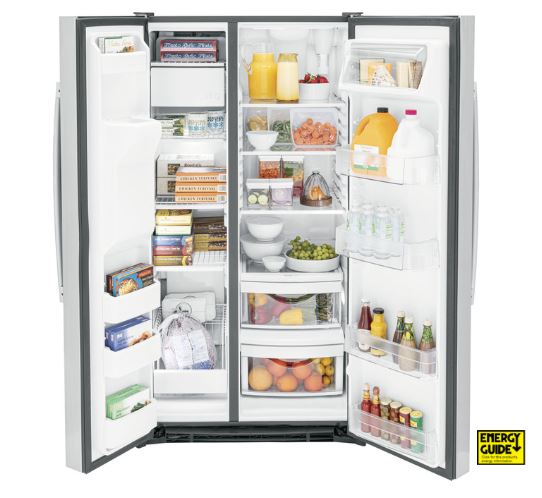
Why Side-by-Side Suits GE’s Strengths
Simpler mechanical designs reduce failure points. Single compressor systems are easier to manufacture reliably.
Through-the-door dispensing implements more reliably. Vertical orientation simplifies water line routing.
Door seal requirements are less demanding. The center split reduces stress on individual gaskets.
Manufacturing efficiency drives competitive pricing. GE can offer better value in side-by-side configuration.
GE Side-by-Side Reliability Across Tiers
Base side-by-side models show 9-11% service rates. This matches GE’s overall brand average.
Profile side-by-side units improve to 7-9% failure rates. They approach premium brand reliability.
The most dependable GE refrigerators are basic side-by-sides. Simple designs mean fewer potential failures.
Ice maker issues occur in 3-4% of units. This is lower than French door configurations (4-6%).
Common Side-by-Side Specific Problems
Water dispenser chute freezing happens in humid climates. Ice buildup requires periodic manual clearing.
Narrow compartment width limits large items. This is a design limitation rather than defect.
Temperature imbalance between sides affects older models. One compartment may cool while the other struggles.
Door gasket wear accelerates on heavily-used doors. The refrigerator side typically fails before freezer side.
Best GE Side-by-Side Models for Reliability
Base GE: GSS25IYNFS ($1,400) delivers solid basic performance. Simplicity equals reliability.
Profile: PSS28KYHFS ($2,200) adds smart features. This represents excellent value in side-by-side category.
Café: CSS28CP4NW2 ($3,000) provides commercial styling. Most reliable GE configuration overall.
Budget option: GSE25HYNFS ($1,200) strips features to basics. However, reliability remains acceptable.
Is GE Refrigerator Better Than Samsung? Direct Comparison
This matchup represents the most common buyer dilemma. Both occupy similar price ranges with different philosophies.
Reliability Comparison: GE vs. Samsung
Yale Appliance data shows GE at 8.9% first-year service rate versus Samsung’s 12.4%. This 3.5 percentage point gap is substantial.
Consumer Reports consistently rates GE higher for predicted reliability. Samsung frequently lands in “Fair” categories.
GE’s failure patterns involve simpler, cheaper repairs. Samsung’s issues often require expensive control board replacements.
Over 5 years, GE refrigerators need service approximately 18-22% of the time. Samsung reaches 28-35%.
Feature Comparison: Innovation vs. Reliability
Samsung leads in smart features and innovation. Family Hub screens, internal cameras, and Bixby integration exceed GE’s offerings.
GE Profile offers basic smart features. Wi-Fi connectivity and app control cover essential needs without complexity.
Samsung’s innovative features add failure points. Touchscreens, cameras, and advanced electronics break more frequently.
GE’s conservative approach prioritizes durability. They add features only after proving reliability.
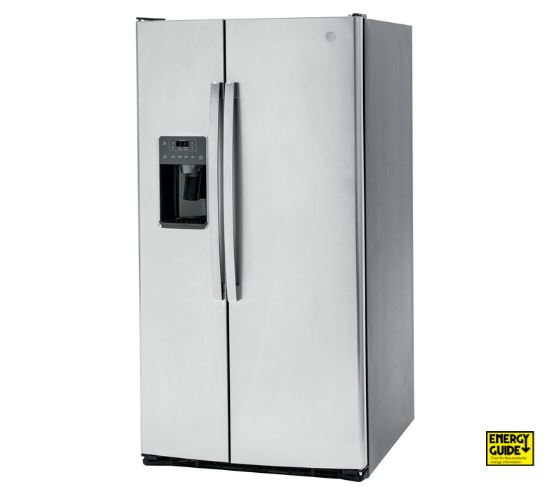
Price-to-Value Analysis
Comparably equipped models cost similarly. A Samsung French door and GE Profile often differ by less than $200.
GE provides better long-term value. Lower service rates and longer lifespans offset similar initial costs.
Samsung’s features appeal to tech enthusiasts. If smart home integration matters most, they deliver.
GE suits buyers prioritizing dependability. The reliability advantage justifies choosing them over Samsung.
Service Network and Support Comparison
GE maintains 12,000+ authorized service technicians nationwide. Rural coverage significantly exceeds Samsung’s network.
Samsung concentrates technicians in urban areas. Small-town service requires long waits or travel charges.
Parts availability favors GE substantially. Common components stock at local suppliers.
Samsung parts often require ordering. This extends repair timelines by days or weeks.
Maintenance Strategies for GE Refrigerator Longevity
Proper care maximizes your GE refrigerator’s lifespan. These practices apply across all tiers.
Essential GE Refrigerator Maintenance Tasks
Clean condenser coils biannually:
- Use vacuum with brush attachment
- Coils behind front grille or rear panel
- Dirty coils reduce efficiency 25-30%
- Prevents 50-60% of compressor failures
- Takes 15-20 minutes twice yearly
Replace water filters every 6 months:
- GE filters (RPWFE, RPWF) or certified alternatives
- Don’t wait for filter change reminder
- Old filters strain water inlet valve
- Costs $40-55 vs. $200+ valve replacement
- Mark calendar for consistent replacement
Monitor door gaskets monthly:
- Check for tears, cracks, or food buildup
- Clean with mild detergent and warm water
- Test seal with dollar bill closure test
- Replace gaskets at first sign of deterioration
- Costs $70-120 vs. higher energy bills
Verify temperature accuracy:
- Use appliance thermometer for verification
- Refrigerator should maintain 37-38°F
- Freezer should stay at 0°F
- Adjust seasonally for kitchen temperature changes
- Internal sensors can drift over time
Tier-Specific Maintenance Considerations
Base GE models require more frequent attention. Check components monthly rather than quarterly.
Profile and Café smart features need software updates. Connect to Wi-Fi periodically for firmware improvements.
Monogram units benefit from annual professional inspections. The complex systems justify preventive maintenance.
All tiers benefit from surge protectors. Control board failures often trace to power spikes.
When Professional Service Makes Sense
Temperature fluctuations despite proper settings require diagnosis. This indicates sensor or refrigerant issues.
Unusual noises (grinding, squealing, buzzing) suggest mechanical problems. Early intervention prevents expensive cascade failures.
Water leaking internally signals drainage problems. Clogged drain lines can overflow and damage components.
Smart connectivity failures may need software resets. GE’s customer service can walk through troubleshooting.
Immediate service indicators:
- Complete cooling system failure
- Burning smell or visible smoke
- Excessive frost buildup despite auto-defrost
- Error codes displayed on control panel
- Water pooling under or inside unit
GE’s FirstBuild community offers troubleshooting help. Online forums connect owners with solutions.
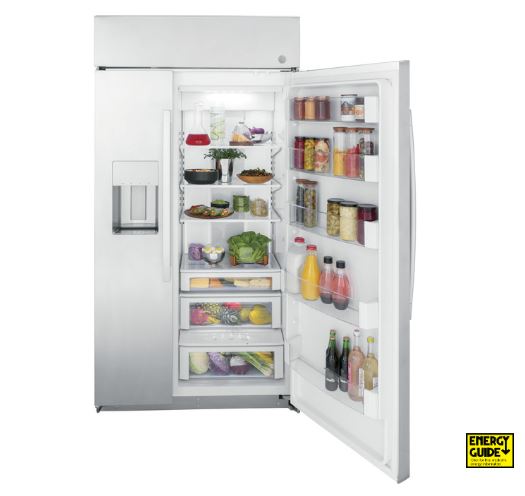
Also Read:
FAQs About GE Refrigerators
Is GE refrigerator a good brand?
Yes, GE is a good refrigerator brand ranking 3rd-4th among major manufacturers for reliability. Their 8.9% first-year service rate beats Samsung, LG, and Frigidaire while trailing only Whirlpool and Bosch. The four-tier system lets buyers choose appropriate quality levels for their budgets.
How long will a GE refrigerator last?
GE refrigerators typically last 13-18 years depending on tier and maintenance. Base models average 12-15 years, Profile reaches 15-18 years, and Monogram can exceed 20 years. This lifespan exceeds industry averages and most Asian competitors significantly.
Are GE refrigerator side-by-side good?
Yes, GE side-by-side refrigerators are among their most reliable offerings with 9-11% service rates for base models and 7-9% for Profile. Their simpler design plays to GE’s manufacturing strengths. They represent excellent value within the GE lineup.
Are GE Profile refrigerators good?
GE Profile refrigerators are excellent value with 7.8% first-year service rates and comprehensive features at mid-range pricing. They offer 80-90% of premium brand performance at 60-70% of the cost. Profile represents GE’s optimal value tier for most buyers.
Are GE Café refrigerators good?
GE Café refrigerators perform well with reliability matching Profile (7-9% service rate). However, they’re mechanically identical to Profile models with $800-1,200 aesthetic premiums. They make sense for coordinated kitchen designs but not for function-focused buyers.
Are GE French door refrigerators good?
GE French door quality varies significantly by tier. Base models show concerning 11-13% failure rates, while Profile improves to 8-10% and Monogram achieves 6-8%. Profile or higher tiers offer acceptable quality, but avoid base French door models.
Is GE refrigerator better than Samsung?
Yes, GE refrigerators outperform Samsung in reliability with 8.9% vs. 12.4% first-year service rates. GE also provides superior service networks and longer lifespans. However, Samsung offers more advanced smart features. Choose GE for reliability, Samsung for innovation.
Final Verdict: Should You Choose GE?
GE refrigerators deliver reliable middle-ground performance that satisfies most buyers. Their 8.9% service rate and 13-18 year lifespan represent solid value, especially in Profile and Café tiers. The four-tier system lets you choose appropriate quality levels, with Profile offering optimal performance-to-price ratio at $2,000-3,200.
Profile specifically deserves strong consideration for mainstream buyers. It matches premium brands’ reliability at mid-range pricing while providing comprehensive features. Side-by-side configurations offer GE’s best value, while French doors require stepping up to Profile or higher for acceptable reliability.
However, buyers prioritizing maximum reliability should consider Whirlpool or Bosch, while tech enthusiasts wanting cutting-edge features might prefer LG. GE occupies the pragmatic middle—dependable, feature-adequate, and well-supported through extensive service networks—making them the sensible choice for most American households.
